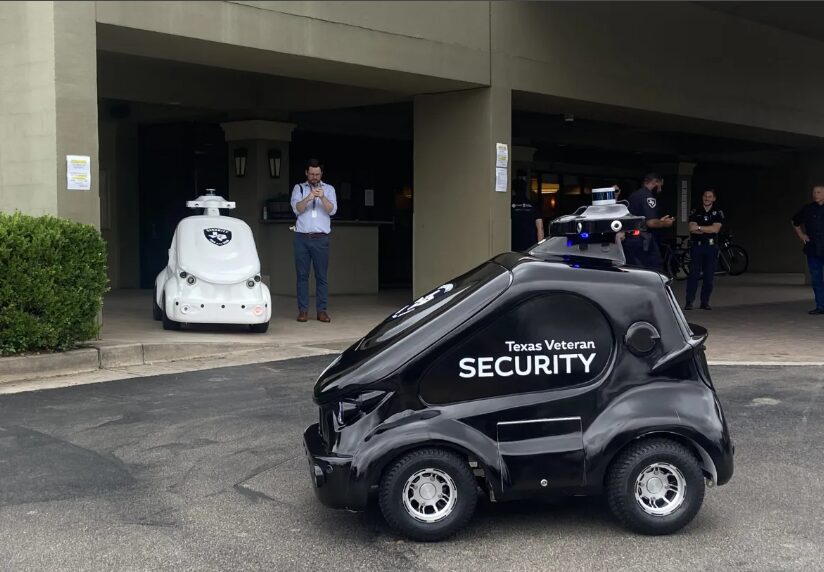Beginning next week, two robots made in Singapore will begin patrolling the perimeter of SAMMinistries’ downtown shelter. Since December 2023, when the nonprofit, giving housing and services to homeless people, opened up the shelter in a downtown San Antonio Holiday Inn, it has contracted with Texas Veteran Security to patrol the site.
Security guards patrol the perimeter of the old hotel — now a shelter — at 318 W. César E. Chávez Blvd. on the west side of downtown, walking and driving around the property 24 hours a day, across three shifts, with 27 guards.
They need more security guards because SAMMinistries increased its capacity for unsheltered people. “We went from a 52-room facility to a 200-room facility. Multiply everything by four, that includes security costs,” said Rex Brien, vice president of Emergency Services for SAMMinistries.
The two new security robots, however, now “save costs” by patrolling the outdoor perimeter 24/7, shelter and security officials say. No guards are being laid off, Texas Veteran Security’s CEO Gerard Morales said, adding 70% of his employees are veterans. Instead, he said, robots would staff capabilities without adding more staff.
“[Guards are] going to be used inside to beef up security, instead of outside watch guards,” Morales said. “Instead of adding people, we’ll be able to view [surveillance] from the guard’s post at the front.”
“Deterrent is what we want from these robots,” he said.
But SAMMinistries said the shelter needs the robots because of its location in a heavy foot traffic area. And with some approvals delaying construction on the exterior fence, according to the nonprofit security needs to guard the perimeter to keep strangers from entering.
The “O-R3” robots, made by Singapore-based robotics maker OTSAW, are autonomous, outdoor surveillance robots that memorize their path, and therefore don’t need to be controlled remotely.
They are capable of patrolling in open areas, detecting and avoiding obstacles with their sensors, and returning back to their charging bases when their charge runs out.
While they patrol the outdoor perimeter, the robots record video and photos of a 360-degree view. The officers don’t have to monitor the cameras of the robots; rather, they will just be alerted in case there is an obstacle in the way, when a person is identified, or if someone asks for help. The capacity of the robots to stop and let a person walk or pass by of a car also exists.
“We’re looking at ways to reduce costs but still keeping safety in mind. We don’t want to compromise safety for our residents [or] our staff,” Brien said.
A week before the robots’ debut at a press event Thursday, Texas Veteran Security paired up with SAMMinistries to brief shelter residents on the new technology they’ll see in the coming days, Brien stated, so they aren’t startled by the cameras, lights, or sirens.
During the presentation, residents sat in a benched area, seemingly unfazed by the new security robots. Others approached to investigate them up close, walking up curiously.
The state of Texas Veteran Security ordered the robots six months ago before they were delivered three weeks ago. Behind him, OTSAW engineers who were present at the shelter set the area periphery so that the robot would memorize its route. Renz Adante, an engineer from Singapore, tried out the robots for the first time at a shelter.
The robots run on Wi-Fi and cellular service. At the shelter, they’ll operate on Elon Musk’s Starlink satellite service, Morales said. They can run for eight hours and then need a two-hour charge. While one guards the property, the other robot will charge, and they’ll switch when needed.
They can also be programmed for facial recognition in order to recognize a certain person. They allow two-way communication from guards inside and the person encountering the robot to help people in the parking lot, and the robots can keep video recordings of their surveillance.
The Siren can relay messages such as, “come to the front of the facility,” for instance. It can handle speed bumps and rough terrain but it is not designed to withstand hard storms.
Brien said the robots will begin a 30-day pilot next week.
“We’ll see if this works for us and it meets the need we have for security and if it is an effective use of our costs.” According to Brien, “It’s not a ‘Hey, this is what we’re doing.'”
According to Morales, the robots will really help bring the cost down by one-third of a guard. His security company will begin offering the robot service to clients that fit the bill for continuous outdoor security.
The first kind in Texas would be SAMMinistries robots, according to OTSAW Commercial Director, Duane Rumski. Some OTSAW robots are already running in New York, New Mexico, and in Washington, said Rumski. There are already 1,000 robots in Europe and Germany.
The San Antonio International Airport recently opted to bring in a robot made by California-based Knightscope Inc.—which had been criticized in other cities—to respond to security alarms.

